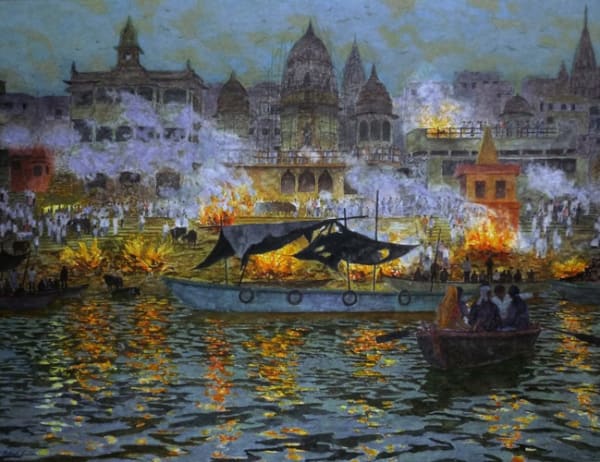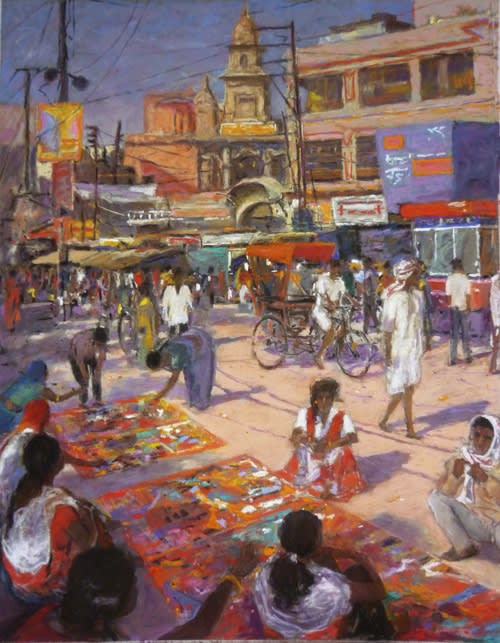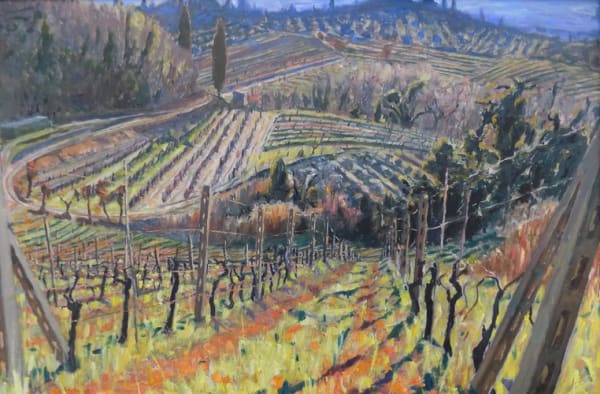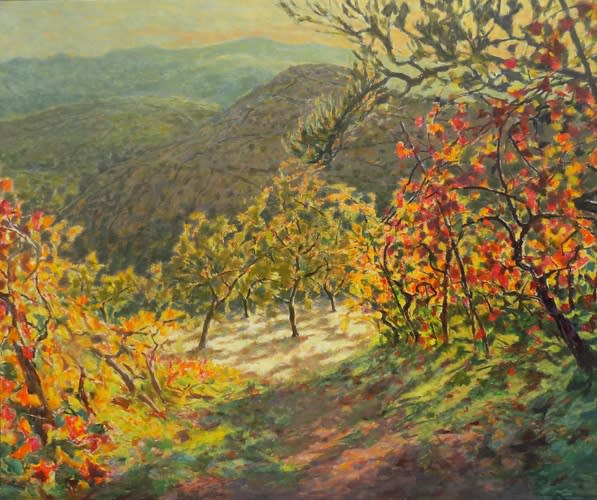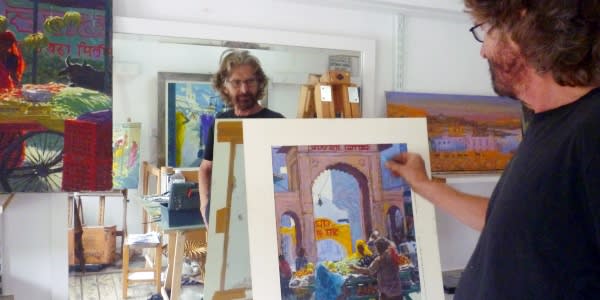Patrick Cullen has been a member of the New English Art Club for twenty years. In this interview, Patrick tells us about his training, method, and influences, and his obsession with colour . . .
"I trained at St Martin’s (foundation year) and then at Camberwell in the 1970s. The teaching of figurative painting was, even by then, sadly dying on its feet. The false idea that creativity was stunted by the learning of techniques and the acquisition of skills had already taken root even in a place like Camberwell with its strong figurative tradition. But I was lucky to encounter one or two older tutors who, if you sought them out, proved to be fountains of painterly wisdom. Dick Lee was a wonderful landscape painter and a good teacher too – always ready to do a little sketch on the edge of your life drawing to put you right, or to go to the library to introduce you to the work of some not-so-well-known artist one should acquaint oneself with.
Much later I became friends with a near contemporary of Dick’s, another brilliant artist, Tom Fairs. We spent some great times mulling over the business of painting and his thoughts were always insightful. Although essentially a naturalistic landscape painter, he worked largely away from the motif back in his studio. “Listen to what the painting needs,” he would say, emphasising the importance of following the dictates of the emerging painting as much as capturing something observed in the external world.
"Good artists borrow; great artists steal"
Picasso said many provocative things – some more provocative than true – but often helpful. I like “What does it mean for a painter to…actually imitate someone else? What's wrong with that? On the contrary, it's a good idea. You should constantly try to paint like someone else. But the thing is, you can't!”
I found that very liberating. I’ve often tried to paint like those I admire, including Dick and Tom. It’s not a question of literally trying to replicate what they do, but simply to borrow what you can and maybe crack one or two of their secrets. Picasso seemed to be saying: It’s ok, you might learn a thing or two and you’ll still be you. Another time he said, “Good artists borrow; great artists steal.” The motive is crucial: envy leads to the desire to misappropriate and to take the credit for what’s not yours. But imitation by the true admirer really is the sincerest form of flattery. Having spent quite some time in the years before I knew him trying to paint a bit like Tom Fairs, you can imagine my delight when once he confessed to me that he’d spent the morning trying to paint a Patrick Cullen!
"A bit obsessed with colour"
I wanted to paint from quite an early age. First memory? Almost literally on my mother’s knee (or perhaps sitting next to her) painting the Rupert Bear Annual picture – it was a feature every year. My mother told me to make the blue sky paler towards the horizon. Her eyes, like mine, are blue. She once told me they were much bluer when she was a child but had become pale because she had cried so much. Maybe it was meant to be a throw-away remark rather than the profound confession of sadness that stayed with me. I’ve even wondered if deep down my love of colour has some unconscious link with a wish to bring back the colour in her eyes.
I have always been a bit obsessed with colour. My favourite artist of all time is Pierre Bonnard. I never cease to be amazed by the alchemy of his colour. No other artist seems to come close to what he does with it. Picasso said “Why do two colours, one put next to the other, sing? Can one really explain this? No.” There are echoes here of Keats’ fear of having the rainbow explained. But Picasso is right and Keats need not have worried. Science can never explain the beauty of the rainbow, only its mechanics. Bonnard seems to be able to arrange colours like an orchestra, so that in his greatest works (the late series of bath paintings for example) the whole painting seems to be singing in some kind of miraculous symphony.
Composition, light, memory, imagination . . .
I nearly always start a painting by sketching in front of an actual scene. Sometimes this will be just a drawing in a sketch book, but often I’ll start drawing directly on to the canvas. The most important aspect for me of this kind of drawing is to establish an overall design for the painting, or its composition. More detailed drawing can be done with the brush or pastel, but if the composition is well founded it saves much scraping-off of paint and redesigning of the painting later on. Some smaller paintings are finished quite quickly entirely in front of the motif and they tend to remain close to what I’m looking at. You might describe them as quite objective – the shapes, colours and tones corresponding more-or-less to the actual scene. But the scene is always changing, particularly the light, and it’s the light I’m most interested in. So, I begin to hone in on a particular light effect which may of course be fleeting. At some point the desire to capture a certain mood and atmosphere associated with the light begins to take over, but as quickly the light changes. The painting then becomes more a work of memory and invention. One may be lucky and return the next day to a similar scene, but it’s rarely the same. In some ways, the remembered scene becomes more interesting than the actual one, because memory is infused with greater subjectivity. And bigger paintings done in the studio, if they’re not to be mere enlargements of smaller studies, will rely still more on memory and imagination. And all the time something else is happening almost unconsciously. The painting itself is making its own demands and one is instinctively responding to them. It needs this shape here to balance that one there; this colour strengthening to set off another close by. This is what Tom Fairs was on about, and it leads into a realm of pure painting as opposed to painting based primarily on observation. I suspect most good figurative artists have a foot in each camp."
Find out more about Patrick Cullen on his artist profile page where you will also find original artworks for sale.
